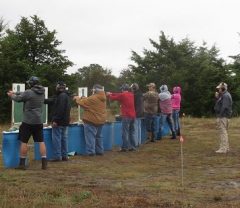by Sandy Keathley
McKinneyCHL.net
Many military surplus rifles from before 1960, especially WWII bolt-action rifles (Mosin-Nagant, Mauser and others) were re-arsenaled in the 1970s and put away for future wars or emergencies. As a rust preventative, they were often disassembled, the parts covered in a heavy grease called Cosmoline, then reassembled and stored for decades. After the mid-1990s, with the knowledge that those rifles were now effectively obsolete, the respective governments started selling them off to exporters who sold them to American companies for resale to collectors.
Even today, years later, these are still showing up, and new collectors are sometimes unclear on how best to clean them up to put them in shooting condition. When the stocks were either varnished or laminated, the grease is easy to remove, but if not, it soaked into the wood and made the wood tacky. While cleaning up such a rifle is tedious, it is not difficult, and treasure is sometimes found underneath!
This description of the process is based around the typical Mosin-Nagant 91/30, but should be applicable to any milsurp rifle that has been packed in grease. Start by separating the action from the stock.
Disassemble the action, removing the bolt and trigger. Disassemble both the bolt and the trigger group completely. Make notes if necessary, so you can reassemble them properly, but there are many videos online for reference. Wipe off all excess grease from the metal parts with paper towels, put them in a pan, cover them with mineral spirits, and allow to sit overnight. After the parts have soaked sufficiently, remove them, wash with soap and water, rinse, dry, then use compressed air to dry more.
At this point, many collectors will use a buffing wheel to carefully deburr any sharp edges, especially on the bolt parts, but that is optional. I also cut 4 loops off of the firing pin spring, and grind the end flat, to make cocking easier. Ammo in the 1940s required a stronger strike than modern ammo, so this won’t affect anything.
If there is any appreciable time between the final rinse and reassembly of the bolt, give the parts a light coating of Rem oil, as these parts will rust quickly. If not, reassemble the bolt. Some people coat all parts with gun oil, but I have had good results with high-temperature Silicone wheel bearing grease. A little trigger oil or grease at the trigger-to-sear interface is also a good idea. Put those parts aside.
Put the receiver end of the barrel into a bucket of mineral spirits and allow to stand for awhile, then pour some down the barrel. Dry as much as possible, then dry with compressed air. Do not wash the barrel. Put the barrel in a padded vise so you can get to the chamber. This is the part many people miss: any cosmoline left in the chamber will, under firing conditions, turn into a hard, sticky residue that will cartridge insertion and extraction very difficult, or impossible. Use an oversized brass bore brush chucked into an electric drill to polish the chamber, using J-B Non-Embedding Bore Cleaner (blue label). A shotgun mop is useful for cleaning out the residue. Follow this with J-B Bore Bright (red label), and the mop again. Now clean the bore and chamber as usual, with solvent and patches.
If the stock is in good shape, reassemble the rifle. If the action is supposed to be shimmed in the stock, make sure those are in place, so you can torque down the action properly.
If, however, the stock is bare wood (Chinese Mosins frequently are), and grease is soaked in, you have more work to do. Using a paintbrush, paint the wood in small sections with mineral spirits, wait just a few minutes, then wipe clean with shop rags or paper towels. You should see grease coming to the surface. Repeat as many times as necessary. If it is summer, and hot outside, lay the stock in the sun, or in a black trashbag, and sweat out the grease. Wipe down, then repeat. This is very tedious, but the wood will never look good or feel good otherwise.
Once you are satisfied with the condition of the wood, you can do one of these to protect it:
- Paint the wood with Howard’s Feed-n-Wax. Let dry, repeat twice.This will be invisible.
- Use Boiled Linseed Oil to create a new but period finish.
- Use Tung Oil or other finish products to create a nice but non-period finish (only if you are not a collector. Among collectors, this is called “bubba’ing“).
Now reassemble the rifle.
